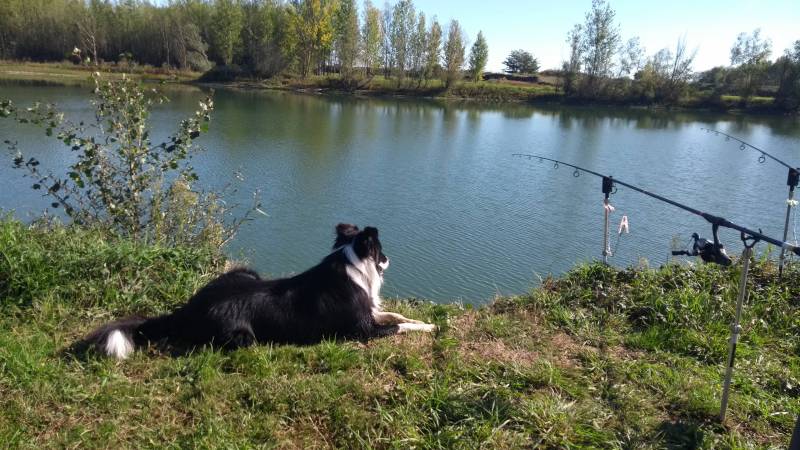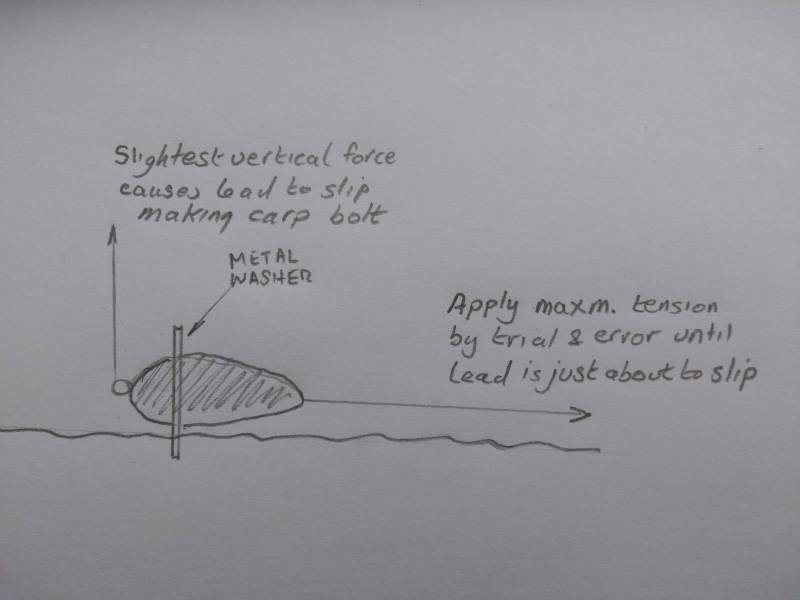-
Posts
510 -
Joined
-
Last visited
-
Days Won
16
Content Type
Profiles
Forums
Gallery
Blogs
Events
Articles
Everything posted by carpepecheur
-
I share your concern if true but where is your evidence.
-
I understand your point Oscha and because I am uncertain, I do soak and boil the maize. However I have scoured the internet for any factual evidence that raw maize swells up inside a carp and kills it. There is plenty of anecdotal evidence but no hard facts. I did read that a well known carp fishery in Eastern Europe fattens their carp with raw maize although again this might be fake news. Who knows these days? Try this test. Put some raw maize in a jar and let it soak for a couple of days and then measure it and tell me how much it has swollen up.
-
Wow, things get really complicated in UK. I use straight forward maize (used for animal feed) at 30p per kilo. I do boil it but I am not convinced even that is necessary. The main requirement is to use lots of it over a long period of time. It also makes a good hookbait with 4 or 5 raw graines fished on a hair. It is quite resistant to crayfish.
-
I have a well-trained border collie and could not contemplate fishing without him. I only have to say the word “fishing” and he is at the door wagging his tail. He will sit and stare at my rod tips all day long. He knows I have a bite before I do and lets me know. I was walking around a local lake yesterday and got chatting to an angler. Dog barked like mad, angler looked up, realised he had a bite, and caught a small perch. His reward is always a swim at the end of a session.
-
Isn't that idea a bit like going to a carp fishery?
-
Yes Davyd, I'm afraid it is. Sorry ,I should have posted a link to the story. Here is one example Deaths on Everest by BBC I title the photo "The end of the world is nigh" on other sites because I think it is a great metaphor for the state of the world today. I think it was Isaak Newton who said he made progress "by standing on the shoulders of giants". Well if there are too many people doing it, the photo is a good warning of what might happen.
-
You know how everyone goes to great lengths to post a cheesy selfie holding their latest big catch, (I also plead guilty to that!), well the following photo of Mount Everest in today’s Guardian puts that into perspective.
-
That is an immaculate fish Chillfactor and congratulations ... and it certainly had a large hoover. Until you brought up the subject I had never given much thought as to HOW a fish sucks up a bait. I vaguely imagined it sucked water into its lungs or whatever the carp equivalent of lungs is - the bigger the "lungs" the bigger the suck. As far as I have been able to find out, by reading various papers on the subject on the net, the suction is caused by something called buccal pressure (no, I’ve never heard of it either). The carp opens its mouth quickly causing an area of low pressure. everything in the vicinity of the mouth moves in to replace it so the bigger the mouth (as in your photo) the bigger the suck. But once the mouth is full again the suction stops. If you imagine a carp opening its mouth 1 foot above a bait, to get to the boilie it has to take in the whole water column in between. Even with a very large mouth it is hard to see how this would work at that distance. I have just looked at a lot of the underwater videos on YouTube of carp sucking bait. They tend to confirm the action described. They open their mouth and take in one mouthful of suck then have to repeat again. I did see one clip where a carp seemed to swim above a boilie then tilt towards, it suck it up and disappear in a swirl of silt. On stepping through it frame by frame however it was obvious that, at the point of taking, the bait the mouth was very close to the boilie. So I am wondering, Chillfactor , if this is the sort of thing you observed? I spent an hour in the workshop testing this today. I have a carp mouth sized pipe fitted with a plunger. A rapid pull on the plunger replicates the reduced buccal pressure as a carp sucks the bait. I tested a normal boilie, a wafter and pop up weighted so that it only just sank. On no occasion could I get the bait to move unless I was only centimetres away from it. I cannot convince myself that I am missing bites from a carp 1 foot away therefore I will continue to use my 6 cm (sic) hooklink. I have, however, learned a lot today.
-
I agree with everything you say apart from "a mid twenty can suck up boillies from over 1ft away". I am not saying it is incorrect just that it is a lot for me to get my mind around. I should imagine it depends on how bouyant a bait is. A wafter is obviously more "suckable" than a heavier bait. Even so, imagine sucking up some sherbet with a straw. Obviously, if you get close, it is easy but you don't have to get very far away from the sherbert before no amount of sucking will have any effect. I wish I was clever enough to work out the physics of the situation. You have certainly provided food for thought though.
-
That is excellent point. The question is how back can a carp still suck up a bait. I do tests with a suction tube in a tank and find it takes an exponential amount of extra suck the further you get from the bait? The next question is how does the carp react when it finds the bait tethered by a short link? Does it back off or move closer to take it? I don't have any ideas I just like thinking about it.
-
Wow. With all the time and money invested in fishing it is hard to imagine anyone not sharpening their hook each time. It must be the easiest ,cheapest and most effective thing you can do.
-
I can't remember the last time I lost a fish once hooked. I do use micro barbed hooks, maybe that helps. I think some people put forward a lot of theories that sound good but have no basis when actually put to the test.
-
Personally, I would use around 6 cms. That seems to be just the right length to get the bait into the mouth before it tightens against the lead. My thinking is that any longer length just gives the carp more time to eject the bait.
-
I am grateful for your misunderstanding because it has given me another idea to follow up. That’s the big benefit of forums like this. I don’t need an edge over other anglers because I am lucky to be able to fish waters with virtually no other carp anglers on them. My main competition is with myself.
-
It suits my style of fishing - big open snag free waters. Depends which side of the "slack lines versus tight line" argument you favour. For me it so simple, cheap and effective it is a no brainer.
-
Judging by the replies it seems I have not explained the Active Lead system very well. I live the life of a recluse and have no contact with other anglers (apart from the odd digital exchange such as this) so communication is not a strong point of mine. I will try and be a bit clearer. First of all the lead is a bog standard, in line, torpedo or bomb shaped lead. It has a swivel at the blunt end which detaches in the event of a crack off to avoid a carp dragging the lead around for the rest of its natural. The ONLY difference I make is to hammer a steel washer onto the slimmer end. Ok I sometimes paint it black. It is no more complicated than that. It may lack some aerodynamic qualities but, because of arthritis, I always use a bait boat so that does not bother me. You use it in exactly the same way as any other in line lead. You wind in the slack line but then gradually increase the tension until you have a slight bend in the rod. If it slips whilst doing this, repeat a couple of times until it holds. Unless the lake bed is completely smooth this doesn’t take much. You sit there and watch your rod tip. All the time your rod maintains a bend then you know your bait is untouched. The slightest movement by a fish of any description will cause the weight to slip and the tip to straighten. If it is a carp then it is usually followed by a one toner as it bolts, frightened by the sudden small movement. It may only be a small bream, in which case it might not get the bait in its mouth but it can still release the tension with just a very small tug. So, if you see your rod has straightened but no line is taken out, you know immediately that the bait has been interfered with. I have found by trial and error that a weight of around 60 grams is ideal. I have been using this system for over 5 years now and rarely miss a take. The secret to its success is, I believe, a short hook link – which is where this discussion started.
-
I can only describe what works for me Leonard and what I find easiest to use with confidence. Chacun à son truc as they say around here.
-
I am not sure what you mean in the last line of your post Gordon. Once the the rig is set the only force is upwards when a fish takes. In my experience I very rarely miss a take. In that rare event, I always know I have been done because the rod has straightened. I have also observed the same thing as you when a carp drops a bait that seems to have been taken well. That is why I dropped using a hair and put the boilie directly on the hook link in a rig I call "The Spinner". I made a rather poor quality youtube clip of it to try and explain it to some one. It s only a tank test using an artificial mouth but I think you will get the idea.
-
I found a you tube clip I made 5 years ago where I tested it in my swimming pool which might help show the idea.
-
Good question but that is not how it works. The washer is forced onto the lead so that is a permanent fixture. You have to experiment to get the washer to match the lead diameter. The downside is that there is a bit of drag when you retrieve it but with a fish on you would never know it was there. I will try and add a photo of one.
-
My sincere thanks, Leonard, for your disapprobation of my comments. It tends to lend them more gravitas than they deserve. You admit “can't pretend I understand the theories perfectly to be honest” which speaks volumes. I have spent a lot of time testing, filming, and comparing techniques and am happy with my conclusions. If you have trouble coping with ideas on this forum I suggest you make yourself nice and comfortable under that bridge of yours. I remember now why I rarely post on forums these days.
-
It would be more difficult to get the small initial movement that I am looking for when using a heavier lead. I tend to use 60 grams. I have experimented with the leads with small anti slip nodules on. I think they are called cling ons or something similar. They do work but not quite as well. It was Fank Warwick's work with adding a split shot to the curve of the hook to get it to drop into the bottom lip that led me to develop my spinner rig. I filmed the mechanics of a shot on the bend of the hook and it did work up to a point (pardon the pun). It seemed to work better with small baits and long hairs and also depended on the vertical angle of the fish. If the fish was vertical it could take the bait straight out of the mouth. With a spinning bait the hook rotates in the mouth finding a hold irrespective of these variables. I have found something that I can understand, am comfortable with and have confidence in. IMHO, above everything else, confidence is paramount.
-
I agree with Greekski. The shorter the better but specifically when using a bolt lead. If you are using a running leger style of rig then perhaps the thinking may change and of course the presence of weed and silt need to be considered. The length needs to be just long enough to allow the carp to take the bait into its mouth then the bolt effect should do its magic. If you have a longer link you are simply giving the carp more time to eject the bait. I add an extra twist to the bolt effect. I force a wide steel washer onto a bomb style lead so that it is just the angler side of the centre of gravity. I then wind my line as tight as I can, getting the washer to dig in. I use mono for its stretch and also put a bend into the rod fished sea angler style. When the bait is taken, just a very small upwards force is required from the fish to cause all the tension in the line and rod to release the lead and jerk it towards the angler. This movement may cause a hooking action in itself but I believe that the small movement panics the fish into bolting before it has time to eject the bait. I will try and upload a diagram to show what I mean. If I am using a boilie I give myself an extra edge by not using a hair. I have a rig that spins the bait the moment the bait is picked up and spins the hook inside the mouth looking for a hold. It works perfectly for me but again it relies on a short link.
-
It is some years since I experimented with pop ups and never really found them more successful than bottom baits. That may be because I fish relatively deep water (7 to 10 metres). I can imagine that natural food which does waft around in shallow water will sit flat on the bottom at greater depth due to its reduced buoyancy so fish expect stuff to waft around at shallow depths and not at greater depths. However, as I said, this is pure speculation. I totally agree about creating a feeding situation. My most successful technique is heavy and prolonged pre-baiting with a single bait usually either maize or VERY cheap boilies. Fortunately hardly anyone else fishes the places I do so I do not have to worry about other anglers cashing in on my hard work.









